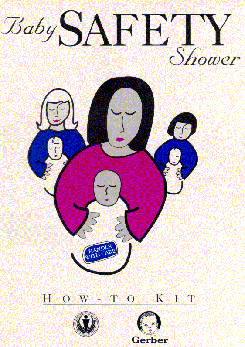
Since 1991 every September has been designated as Baby Safety Month.
An average of 80 fatalities related to nursery products are reported annually. Most deaths are associated with cribs, baby baths/bath seats, and playpens. Falls from infant carriers/car seats, cribs, and strollers/carriages were associated with the majority of the estimated 66,400 U.S. emergency department treated injuries to children younger than 5.
Tip-Overs: There were 180 reports of fatalities between 2000–2006 related to tip-overs of furniture, televisions or appliances. Children younger than 3 years of age comprised 62 percent of these deaths.
Window Falls: About 3,700 children younger than 10 years of age are treated annually, on average, in U.S. emergency departments for injuries associated with falls from windows. Annually, an average of nine children younger than 10 years of age die as a result of injuries associated with falls from windows.
Drowning: An average of 104 children younger than 5 years of age drown annually in home products such as bathtubs, buckets, and decorative yard equipment.
Choking: In 2007, there were an estimated 3,400 choking injuries to children younger than 3 that were treated in U.S. emergency departments.
Poisonings: An average of 33 reports of poisoning fatalities for children younger than 5 years of age are received annually. More than 81,000 unintentional child poisoning incidents were treated in U.S. emergency departments in 2006.
Toys: There were 22 toy-related deaths for children younger than 15 years of age. Riding toys, toy nails and pegs and rubber balls were associated with most of the deaths. During that same year, an estimated 165,100 children younger than 15 were treated in U.S. emergency departments for toy-related injury.
Suffication: Never place pillows or thick quilts in a baby’s sleep environment. Also, make sure there are no gaps larger than two fingers between the sides of the crib and the mattress.
Crib Setup: Proper assembly of cribs is paramount — Follow the instructions provided and make sure that every component included is used. If you are not sure, call the manufacturer for assistance.
Used Cribs: Do not use old, broken or modified cribs — Infants can strangle to death if their bodies pass through gaps between loose components or broken slats while their heads remainentrapped.
Play Yards: Properly set up play yards according to manufacturers’ directions — Only use the mattress pad provided with the play yard.
Curain Cords: Never place a crib near a window with blind or curtain cords — Babies can strangle on curtain or blind cords
Educating Your Neighbors about Baby Safety
Many of your neighbors may benefit from a better understanding of baby saftey – it might even save a baby's life! Baby Safety Month is an excellent opportunity to organize a baby safety event for your community.
Neighborhood Link suggests organizing a baby safety shower -- a baby shower with a new twist.
A baby safety shower is a learning party where all the activities revolve around home safety themes. Parents and caregivers have fun -- and leave with new ideas about keeping their babies safe at home.
The U.S. Consumer Product Safety Commission and Gerber Products Company developed this baby safety shower initiative to help good parents become even better ones. After all, no parents are born knowing about safety for their babies.
Baby safety showers have been organized in all kinds of communities for all kinds of audiences. As First Lady Hillary Rodham Clinton said when she attended the kick-off Baby Safety Shower in Washington, DC, "I hope families all over America will have baby safety showers (to) educate each other about what we need to do to keep all of our babies safe and healthy." These showers are an especially good way for local organizations to reach new parents and parents-to-be with important safety information.
These resources are produced by the U.S. Consumer Product Safety Commission and are therefore not bound by typical copyright laws and can be legally reprinted and used in your efforts to educate your neighbors.
Arranging Publicity for your Neighborhood Event

Publicizing your shower can have many benefits. It can announce details of your upcoming shower to your target audience. It also can alert businesses, local elected officials, media celebrities, and other community leaders to your efforts and attract their support.
Notify the local media about your event. Follow up with personal calls to the news or community events director.
It helps if there is a well-known person associated with your shower. For example, you may want to invite a well-known VIP, like the mayor or a local TV personality. Try enlisting a radio or television show or local newspaper as a sponsor of the shower. These organizations often are interested in supporting community efforts important to their audiences.
Don't forget the value of fliers posted in grocery stores, drugstores, libraries, bus stops -- any public location where your targeted audience is likely to see them.
Baby SAFETY Shower HOW-TO-KIT
Part Two: Developing Your Shower Program
Part Three: Putting Your Shower Together
 Print
Print Email
Email







